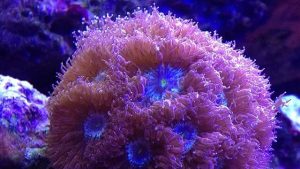This post may contain affiliate links. As an amazon associate I earn from qualifying purchase. Learn more
You want to learn about Blastomussa Coral care, but you don’t know where to start.
Don’t worry, I’ve got you covered.
For any new coral you want to purchase, you need to pay close attention to its requirements. It’s no different with the Blastomussa Coral. In today’s post, you are going to learn everything is out there about Blasto coral care.
It’s actually not as difficult as you’d think. You just need to carefully follow the instructions.
Here’s how you do it:
Related: Acan Coral Lighting

Contents
Blastomussa Coral Care
Blastomussa wellsi commonly referred to as Blasto Coral is a type of a large polyp stony (LPS) coral, native to Indo Pacific Ocean, including Solomon Islands, Fiji, and the Great Barrier Reef. It inhabits lower reef slopes and turbid environments.
Before we dive into the specifics, let’s talk a little bit about the basics of taking care of Blasto Coral.
Blastomussa are hardy corals, they are easy to care for, and they have low requirements. In general, Blastomussa wellsi is a peaceful coral, however, for the safety of the tankmates, don’t place it near other corals.
Weekly water changes are mandatory, with the addition of supplementary elements if needed.
For additional care tips and more specific information on the other aspect of keeping Blastomussa corals such as the placement, lighting, and feeding, keep reading.
Blastomussa Coral Placement & Lighting
The first thing that comes to mind to people when they think about LPS corals in general, is that they are aggressive by nature. Which they certainly are.
So I can see why it can be a deal-breaker for some folks, and why they never pulled the trigger buying them, even though they think these types of corals are awesome. What if I tell you that’s not entirely true with this particular coral?
Blastomussa wellsi is an LPS coral, like I’ve mentioned earlier, which means that it has sweeper tentacles capable of extending during the night hours. And we all know that all LPS corals, with those tentacles, can harm other corals near them. However, in comparison with other LPS, the Blastomussa Coral is relatively weak in terms of aggressiveness. Don’t forget that they are delicate too, and they can be harmed by other more aggressive corals.
If you want to have success in keeping Blasto corals in your tank, you need to acclimate them slowly and carefully. Place them in a low light area, and gradually move them until you find the perfect place. One of the many good things about these corals is that they are quite adaptable to low light. In fact, they may even thrive under those conditions.
Blastomussa wellsi requires low to moderate water flow.
Blasto Coral Feeding
In the wild, Blastomussa has developed several different ways of getting its necessary nutrients.
It’s no different in home aquariums.
It will get its most essential nutrients from the lighting, by photosynthesis, through zooxanthellae, marine algae that live within the coral. That’s its primary source of food.
The second source of food is through the water column. Blasto corals are capable of consuming a range size of plankton.
Of course, for faster growth and better health, it’s always advisable to feed them occasionally with other types of food. It’s not necessary, but a good practice to grow better specimens.
My Recommendation: Polyplab – Reef-Roids
Before we wrap it up this section about Blasto coral feeding, I’d like to mention one more thing. Maintaining the correct levels of calcium and alkalinity is of great importance to the overall health of the coral. After all, it’s an LPS coral. If by any chance you have lower levels of these elements in your tank, consider adding supplements.
Final Thoughts
I hope you enjoyed reading this article, as much as I enjoyed writing it. Blastomussa wellsi is a great coral to have, and I know it will be a great addition to your reef tank if you ever decide to purchase it.
Once acclimated and established, the Blastomussa Coral can be a centerpiece of your aquarium. It’s relatively easy coral to take care of, it has beautiful appearance and most importantly it has low light requirements.
Now, I’d like to hear from you. What’s your experience with the Blastomussa Coral.
Let’s discuss this in the comment section.
Featured Image: Aaron Gustafson (CC BY 2.0)
Well done to the author. A excellent article.
My Blastomussa has wedged into my rock-scape will it continue to grow if if its “stony-sides” are embedded in the rock? (The Polyps are sticking out though.)